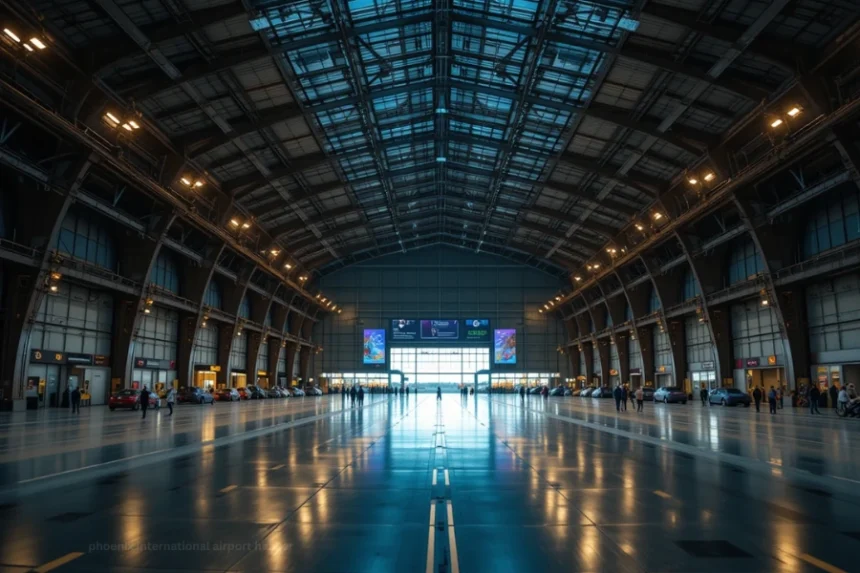Introduction to Phoenix International Airport Hanger
Phoenix International Airport, also known as Phoenix Sky Harbor International Airport, is one of the busiest airports in the United States. As a major hub for both domestic and international flights, it boasts a vast infrastructure that includes numerous hangars essential for aircraft maintenance, repair, and storage. The Phoenix International Airport Hanger plays a critical role in ensuring smooth airport operations, safety, and efficiency for the airlines and other stakeholders. This article provides a comprehensive overview of the significance, features, and future developments of the Phoenix International Airport Hanger.
What Is a Hanger at Phoenix International Airport?
A hanger (or hangar) is a large covered structure designed house aircraft, provide protection from elements, or facilitate maintenance or storage. At Phoenix International Airport, hangars are critical infrastructure supporting private aviation, commercial, and cargo flights. They serve multiple purposes—ranging from simple aircraft storage to complex maintenance and repair operations.
Hangars are often custom-built or leased spaces that allow aircraft owners, maintenance providers, and aviation companies to secure their assets efficiently.
Types of Hangars Available at Phoenix International Airport
Phoenix International Airport offers various types of hangar facilities, tailored to different needs and aircraft sizes:
T-Hangars
T-hangars are smaller, individual units with a typical T-shaped floor plan, ideal for private aircraft owners and small jets. These are perfect for personal or corporate aircraft storage, offering easy access and cost efficiency.
Corporate or Executive Hangars
Larger than T-hangars, these facilities accommodate business jets and small commercial aircraft. They often come with additional amenities such as offices, lounges, and maintenance areas.
Maintenance Hangars
These sizable structures are equipped with specialized tools and equipment and are used for aircraft maintenance and repair. They are used by aviation service providers and maintenance companies.
Cargo and Commercial Hangars
These large facilities are built to handle high-volume cargo traffic, passenger aircraft, or airline operations. They often include loading docks and security features tailored for commercial operations.
The Importance of Hangar Expansion and Modernization
As Phoenix International Airport continues to grow, so does the need to expand and modernize its hangar facilities. Recent developments include constructing new hangars equipped with environmentally friendly technologies, such as solar power systems and energy-efficient lighting. These upgrades are part of broader efforts to reduce the airport’s carbon footprint and promote sustainability within the aviation industry.
Modernization also involves integrating digital technologies like maintenance management systems and real-time tracking of aircraft status. These innovations improve operational efficiency, reduce turnaround times, and enhance safety protocols. In order to further streamline workflows, the future hangar at Phoenix International Airport plans to integrate automation and robotics for jobs like aircraft cleaning and part replacement.
The Role of the Phoenix International Airport Hanger
Hangars at Phoenix Sky Harbor serve multiple purposes, including aircraft storage, maintenance, and repair. These structures are designed to accommodate various aircraft sizes, from small private jets to large commercial airliners. The primary role of the Phoenix International Airport Hanger is to provide a secure environment where aircraft can be protected from the elements, undergo routine maintenance, and be prepared for flights safely and efficiently.
Aircraft maintenance within these hangars is critical for ensuring safety and compliance with regulatory standards. Regular inspections, engine checks, and repairs are performed within these spaces, minimizing delays caused by technical issues and prolonging the lifespan of aircraft.
Features of the Phoenix International Airport Hanger
Phoenix’s airport hangars are equipped with modern facilities and advanced technology to support efficient operations. Some of the key features include:
Size and Capacity: The airport’s hangars are expansive, with some covering thousands of square feet, allowing them to host multiple aircraft simultaneously.
State-of-the-Art Equipment: Cutting-edge tools and diagnostic equipment are used for maintenance and repairs, ensuring quick and accurate assessments.
Security Measures: Tight security, including surveillance cameras, restricted access, and personnel screening, are implemented to safeguard aircraft and sensitive equipment.
Environmental Controls: Advanced climate control systems help maintain optimal conditions within the hangars, protecting aircraft components and maintenance tools from extreme weather effects.
Specialized Facilities: Some hangars are designed for specific aircraft types, including cargo planes, private jets, or military aircraft, providing tailored services for each.
Benefits of Leasing or Owning a Hanger at Phoenix International Airport
Security and Protection
Aircraft are shielded from weather-related damage, theft, and vandalism by a hangar. Phoenix’s desert climate demands proper storage, especially during monsoon seasons or extreme heat.
Convenience
Having quick access to the aircraft saves time on pre-flight preparations, maintenance, and operational logistics. It also simplifies compliance with safety standards.
Asset Preservation
Proper storage in a dedicated hangar minimizes exposure to environmental elements like sunlight, dust, and moisture—helping maintain aircraft condition and value.
Business Opportunities
For aviation businesses, owning or leasing a hanger ensures operational flexibility, enhances customer service, and can generate income through leasing additional space or offering maintenance services.
Economic Impact of the Phoenix International Airport Hanger
The area benefits economically from the hangar at Phoenix International Airport. It supports numerous jobs, from aircraft technicians and security personnel to administrative staff. Additionally, the maintenance facilities draw private aviation customers and airline carriers, which increases local business and tourism.
Additionally, Sky Harbor’s standing as a major logistical hub is enhanced by the sophisticated hangar infrastructure, which draws in new routes and encourages airline investments. This economic activity benefits local businesses and enhances Phoenix’s reputation as a global aviation center.
Future Developments and Challenges
The future of the Phoenix International Airport Hanger includes several exciting projects aimed at further improving its infrastructure and capabilities. These include:
- Building larger, more environmentally friendly hangars
- Implementing advanced automation technologies
- Expanding maintenance capacity to accommodate increasing aircraft traffic
- Incorporating renewable energy sources to power hangar operations
However, challenges such as land constraints, regulatory compliance, and the need for skilled workforce remain. Addressing these issues will be crucial for maintaining the airport’s operational excellence and competitiveness.
Conclusion: The Growing Significance of Phoenix International Airport Hanger
The Phoenix International Airport Hanger stands as a vital component of Phoenix Sky Harbor International Airport’s infrastructure. It not only supports daily operations but also symbolizes Phoenix’s commitment to safety, innovation, and sustainability in aviation. As the airport continues to expand and adapt to future demands, the importance of its hangar facilities will only grow, ensuring that Phoenix remains a prominent hub for air travel in the United States.
Whether you’re a traveler, airline operator, or industry stakeholder, understanding the role and advancements of the Phoenix International Airport Hanger provides a glimpse into the intricate world of aviation infrastructure shaping our skies.



